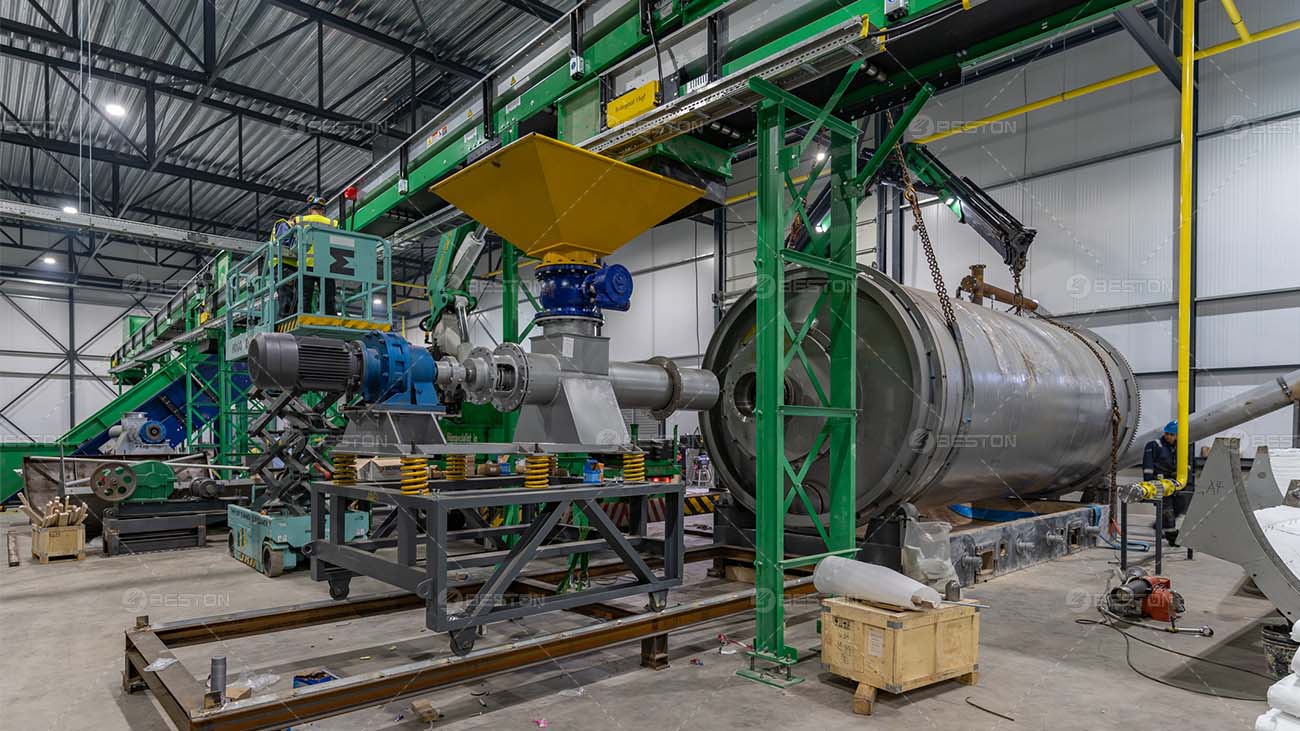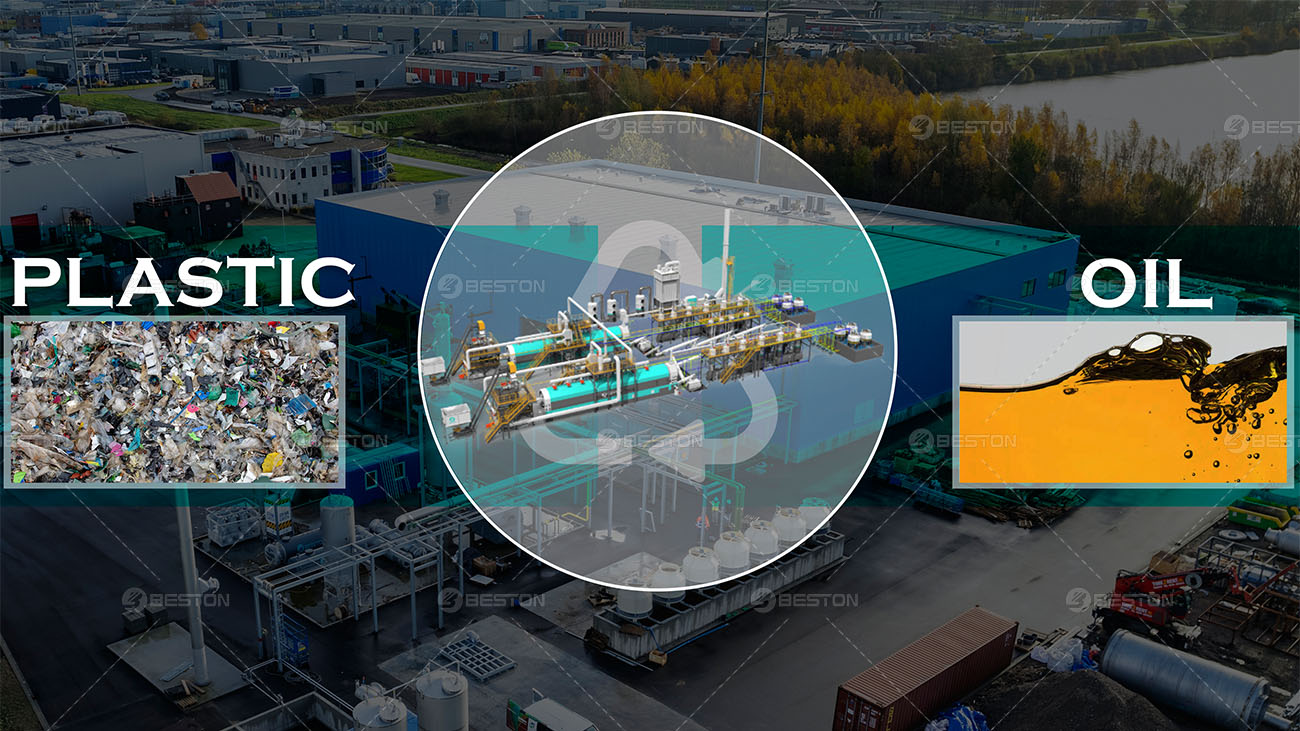Plastic pollution is an escalating environmental crisis, with significant implications for ecosystems and human health. The pervasive presence of plastic waste, including ocean microplastics, necessitates innovative and sustainable solutions. One such promising technology is plastic pyrolysis, which offers a transformative approach to plastic recycling. This article delves into the market prospects of plastic pyrolysis recycling projects in Europe, exploring their potential to address plastic pollution, contribute to sustainability, and align with economic and regulatory trends.

Understanding Plastic Pyrolysis
Plastic pyrolysis is a thermochemical process that converts plastic waste into valuable products such as pyrolysis oil, char, and gases. The process involves heating plastic waste by Beston pyrolysis plant in an oxygen-free environment, causing it to decompose into smaller molecules. This technology provides an effective method for recycling various types of plastics, including those that are difficult to recycle through conventional means.
Advantages of Plastic Pyrolysis
- Diversified Output: Pyrolysis produces multiple outputs, including synthetic fuels, which can be used as alternatives to conventional fossil fuels, and char, which has applications in construction and agriculture.
- Waste Volume Reduction: This process significantly reduces the volume of plastic waste, contributing to waste management efficiency.
- Energy Recovery: The energy recovered from pyrolysis gases can be utilized for heating or generating electricity, enhancing the overall energy efficiency of the process.
Addressing Plastic Pollution
Mitigating Ocean Microplastics
Ocean microplastics represent a major environmental threat, contaminating marine ecosystems and entering the food chain. Plastic pyrolysis offers a viable solution to reduce the input of plastic waste into the oceans. By converting plastic waste into reusable materials, pyrolysis can help mitigate the proliferation of microplastics.
Enhancing Waste Management
Europe generates millions of tonnes of plastic waste annually, a significant portion of which ends up in landfills or incinerated. Plastic pyrolysis provides an alternative to these disposal methods, promoting a more sustainable approach to plastic waste management. The ability to process mixed and contaminated plastics makes pyrolysis an indispensable tool in the fight against plastic pollution.
Sustainability and Circular Economy
Advancing Sustainability Goals
Plastic pyrolysis aligns with global sustainability goals, including the European Green Deal and the United Nations Sustainable Development Goals (SDGs). By transforming plastic waste into valuable resources, pyrolysis supports the transition to a sustainable and circular economy.
Contributing to a Circular Economy
The circular economy model emphasizes the reuse, recycling, and recovery of materials to minimize waste and resource consumption. Plastic pyrolysis plays a crucial role in this model by converting end-of-life plastics into feedstock for new products, closing the loop of plastic usage. This contributes to resource efficiency and reduces the demand for virgin plastic production.
Supporting Zero Net Emissions
Plastic pyrolysis can contribute to achieving zero net emissions by offsetting the use of fossil fuels with synthetic fuels produced from plastic waste. Additionally, the integration of renewable energy sources in the pyrolysis process can further reduce greenhouse gas emissions, aligning with Europe’s ambitious climate targets.

Economic and Regulatory Trends
Market Potential and Investment Opportunities
The market potential for plastic to oil plant is substantial, driven by increasing plastic waste volumes and stringent environmental regulations. The European Union’s Circular Economy Action Plan and the Plastic Strategy aim to enhance plastic recycling rates and reduce plastic waste, creating a favorable environment for pyrolysis projects.
Economic Viability
The economic viability of plastic pyrolysis projects is bolstered by the high market value of pyrolysis products such as pyrolysis oil, which can be refined into diesel or used as a feedstock in chemical industries. The revenue generated from these products can offset operational costs and provide a return on investment, attracting investors and stakeholders.
Regulatory Support
European regulations are increasingly supportive of innovative recycling technologies. The Extended Producer Responsibility (EPR) schemes require producers to manage the end-of-life disposal of their products, incentivizing the adoption of advanced recycling technologies like pyrolysis. Furthermore, government subsidies and grants for sustainable projects enhance the financial feasibility of pyrolysis ventures.
Environmental, Social, and Governance (ESG) Implications
Environmental Benefits
Plastic pyrolysis projects offer significant environmental benefits by reducing plastic waste and lowering greenhouse gas emissions. The recovery and reuse of materials align with environmental conservation efforts, contributing to biodiversity protection and pollution reduction. Beston Group has always been committed to the production of eco-friendly equipment. You can inquire about plastic recycling solutions.
Social Impact
The implementation of plastic pyrolysis projects can create job opportunities and stimulate economic growth in local communities. By addressing plastic pollution, these projects also improve public health and quality of life, fostering a healthier living environment.
Governance and Compliance
Adherence to ESG criteria is increasingly important for investors and stakeholders. Plastic pyrolysis projects demonstrate strong governance by complying with environmental regulations, promoting transparency, and engaging with communities. This adherence enhances the credibility and attractiveness of these projects to ESG-focused investors.
Technological Advancements
Innovations in Pyrolysis Technology
Ongoing advancements in pyrolysis technology are enhancing the efficiency and scalability of plastic pyrolysis projects. Innovations such as catalytic pyrolysis, which uses catalysts to lower reaction temperatures and improve product yields, are making the process more economically viable and environmentally friendly.
Integration with Other Technologies
The integration of plastic pyrolysis with other waste management and recycling technologies can further optimize resource recovery. For instance, combining pyrolysis with mechanical recycling can create a comprehensive waste management system that maximizes material recovery and minimizes residual waste.
Digitalization and Automation
The adoption of digital and automated systems in plastic pyrolysis plants improves process control, efficiency, and safety. Digital monitoring and data analytics enable real-time optimization of the pyrolysis process, ensuring consistent product quality and operational efficiency.
Challenges and Solutions
Technical Challenges
Despite its potential, plastic pyrolysis faces several technical challenges, including feedstock variability, contamination, and energy efficiency. Developing robust pre-treatment processes and advanced catalysts can mitigate these issues, enhancing the reliability and performance of pyrolysis systems. Plus, continuous plastic pyrolysis plant is gradually becoming the first choice for plastic recycling due to their excellent production efficiency.
Economic Barriers
High initial capital costs and uncertain market conditions can pose economic barriers to the adoption of plastic pyrolysis projects. Securing funding through public-private partnerships, government incentives, and venture capital can address these financial challenges.
Regulatory and Public Acceptance
Navigating regulatory frameworks and gaining public acceptance are crucial for the success of plastic pyrolysis projects. Transparent communication, stakeholder engagement, and demonstration of environmental and social benefits can foster regulatory support and public trust.
Future Prospects and Opportunities
Expanding Market Reach
The future prospects for plastic pyrolysis recycling projects in Europe are promising, with opportunities to expand market reach and diversify product offerings. The development of standardized regulations and quality certifications for pyrolysis products can facilitate market acceptance and growth.
Research and Development
Continued research and development in pyrolysis technology are essential to overcome existing challenges and unlock new applications. Collaborative efforts between industry, academia, and government can drive innovation and accelerate the commercialization of advanced pyrolysis solutions.
Strategic Partnerships
Strategic partnerships between waste management companies, chemical manufacturers, and technology providers can enhance the value chain of plastic pyrolysis projects. These collaborations can lead to integrated waste management systems that maximize resource efficiency and sustainability.
Conclusion
Plastic pyrolysis recycling projects hold significant market prospects in Europe, offering a sustainable solution to the pressing issue of plastic pollution. By converting plastic waste into valuable resources, these projects contribute to a circular economy, support sustainability goals, and align with regulatory and economic trends. The successful implementation of plastic pyrolysis projects requires addressing technical, economic, and regulatory challenges through innovation, investment, and collaboration. As the demand for sustainable waste management solutions continues to grow, plastic pyrolysis stands out as a key technology with the potential to transform the plastic recycling landscape in Europe.